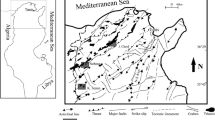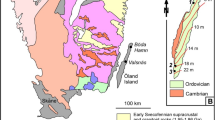Summary
The Middle Devonian Hollard Mud Mound is situated in the eastern Hamar Laghdad, which is a small mountain range in the Tafilalt in SE Morocco. In contrast to the well known Lower Devonian Kess-Kess mounds, the Hollard Mound is of Middle Devonian age. The facies in the core of this mud mound differs from that of the other parts of the mound, and exhibits signatures of ancient hydrocarbon venting. The carbonate phases of the core facies are derived from the oxidation of vent fluids and consist of clotted micrite, a cryptocrystalline carbonate associated with spheres of uncertain origin, and a calcitic rim cement (rim cement B). These vent carbonates show δ13C values in the range of −11 to −20% PDB indicating that some of their carbon is derived from isotopically light hydrocarbons. Fossiliferous micrite has been affected by hydrocarbon venting in the proximity of the vent site, which is indicated by intermediate δ13C values between vent carbonates and not affected sediments. Bivalves occur in dense populations within the core facies. They form autochthonous shell accumulations and are almost exclusively articulated. it is likely that these bivalves were dependent on chemosynthesis similar to their counterparts at modern vents. The vent deposits also exhibit an unusual prasinophyte assemblage, which might have been linked to the specific nutrient availability at the vent site.
The ancient vent site is characterized by an enhanced carbonate precipitation and rapid lithification. The latter is corroborated by the three-dimensional preservation of phytoplankton (prasinophytes and acritarchs) and the occurrence of stromatactoid pores. An early phase of carbonate corrosion predating the formation of vent carbonates affected the fossiliferous micrite of the core facies and is thought to be related to a phase of H2S-rich venting.
Similar content being viewed by others
References
Arp, A.J. &Childress, J.J. (1981): Blood function in the hydrothermal vent vestimentiferan tube worm.—Science,213, 342–344, Washington D.C.
Barry, J.P., Greene, H.G., Orange, D.L., Baxter, C.H., Robison, B.H., Kochevar, R.D., Nybakken, J.W., Reed, D.L. &McHugh, C.M. (1996): Biologic and geologic characteristics of cold seeps in Monterey Bay, California.—Deep Sea Research,43, 1739–1762, Oxford
Bathurst, R.G.C. (1980): Stromatactis-Origin related to submarine-cemented crusts in Paleozoic mud mounds.—Geology,8, 131–134, Boulder
Beauchamp, B., Krouse, H.R., Harrison, J.C., Nassichuk, W.W. &Eliuk, L.S. (1989): Cretaceous cold seep communities and methane-derived carbonates in the Canadian Arctic.—Science244, 53–56, Washington D.C.
Beauchamp, B. &Savard, M. (1992): Cretaceous chemosynthetic carbonate mounds in the Canadian Arctic.—Palaios,7, 434–450, Tulsa
Bechstädt, T. (1974): Sind Stromatactis und radiaxial-fibröser Calcit Faziesindikatoren?.—N. Jb. Geol. Paläontol. Mh.,1974, 643–663, Stuttgart
Belka, Z. (1994): Carbonate mud buildups in the Devonian of the central Sahara: evidences for submarine hydrothermal venting.— Przeglad Geologiczny,42, 341–346, Warszawa
Belka, Z. (1995): Devonian mud mounds in North Africa related to submarine hydrothermal venting.—In:Kurze, M. (ed.): Sediment ’95, 10. Sedimentologentreffen, Kurzfassungen der Vorträge und Poster.—13–14, Freiberg
Belka, Z. (1997): The origin of the Early Devonian Kess-Kess mud mounds of the eastern Anti-Atlas (Morocco): Evidence for submarine venting of methane-rich fluids.—In:Camoin, G. & Arnaud-Vanneau, A. (eds.): Microbial Mediation in Carbonate Diagenesis, Abstract Book, 5–6, Chichilianne
Belka, Z. (1998a): The origin of the Early Devonian Kess-Kess mud mounds of the eastern Anti-Atlas (Morocco): Evidence for submarine venting of methane-rich fluids.—In:De Mol, B. (ed.): Geoshere-bioshere coupling: Carbonate Mud Mounds and Cold Water Reefs.—UNESCO Workshop Report,143, 17–18, Gent.
— (1998b): Early Devonian Kess-Kess carbonate mud mounds of the eastern Anti-Atlas (Morocco), and their relation to submarine hydrothermal venting.—J. Sed. Research,68, 368–377, Tulsa
Bitter, P.H. von, Scott, S.D. &Schenk, P.E. (1990): Early Carboniferous low-temperature hydrothermal vent communities from Newfoundland.—Nature,344, 145–148, London
Bitter, P.H. von, Scott, S.D. &Schenk, P.E. (1992): Chemosynthesis: An alternate hypothesis for carboniferous biotas in Bryozoan/ Microbial Mounds, Newfoundland, Canada.— Palaios,7, 466–484, Tulsa
Brachert, T.C., Buggisch, W., Flügel, E., Hüssner, H.M., Joachimski, M.M., Tourneur, F. &Walliser, O.H. (1992): Controls of mud mound formation: the Early Devonian Kess-Kess carbonates of the Hamar Laghdad, Antiatlas, Morocco.— Geol. Rundschau,81, 15–44, Stuttgart
Campbell, K.A. (1992): Recognition of a Mio-Pliocene cold seep setting from the northeast Pacific convergent Margin, Washington, U.S.A..—Palaios,7, 422–433, Tulsa
Campbell, K.A. &Bottier, D.J. (1995): Brachiopods and chemosymbiotic bivalves in Phanerozoic hydrothermal vent and cold seep environments.—Geology,23, 321–324, Boulder
Campbell, K.A., Carson, C. & Bottjer, D.J. (1993b): Fossil cold seep limestones and associated chemosynthetic macro-invertebrate faunas, Jurassic-Cretaceous Great Valley Group, California.—In:Graham, S.A., Lowe, D.R., (eds.): Advances in the Sedimentary Geology of the Great Valley Group, Sacramento Valley, California.—Soc. Econ. Paleontol. Mineral., Pacific Section, Book73, 37–50, Tulsa
Cavanaugh, C.M. (1983): Symbiotic chemoautotrophic bacteria in marine invertebrates from sulfide-rich habitats.—Nature,302, 58–61, London
Cavanaugh, C.M., Levering, R.R., Maki, J.S., Mitchell, R. &Lidstrom, M.E. (1987): Symbiosis of methylotrophic bacteria and deep-sea mussels.—Nature,325, 346–348, London
Childress, J.J., Fisher, C.R., Brooks, J.M., Kennicutt, M.C., Bidigare, R. &Anderson, A.E. (1986): A methanotrophic marine molluscan (Bivalvia, Mytilidae) symbiosis: Mussels fueled by gas.—Science233, 1306–1308, Washington D.C.
Clari, P., Fornara, L., Ricci, B. &Zuppi, G.M. (1994): Methane-derived carbonates and chemosymbiotic communities of Piedmont (Miocene, northern Italy): An update.—Geo-Marine Letters,14, 201–209, Berlin
Collins, M.J., Bishop, A.N. &Farrimond, P. (1995): Sorption by mineral surfaces: Rebirth of the classical condensation pathway for kerogen formation?.—Geochim. Cosmochim. Acta,59, 2387–2391, Oxford
Corliss, J.B., Dymond, J., Gordon, L.I., Edmond, R.P., von Herzen, R.P., Ballard, R.D., Green, K., Williams, D., Bainbridge, A., Crane, K. &van Handel, T.H. (1979): Submarine thermal springs on the Galapagos Rift.—Science,203: 1073–1083, Washington D.C.
Dando, P.R., Austen, M.C., Burke, R.A., Kendall, M.A., Kennicutt, M.C. II, Judd, A.G., Moore, D.C., Schmaljohann, R. &Southward, A.J. (1991): Ecology of a North Sea pockmark with an active methane seep.—Marine Ecology Progress Series,70, 49–63, Halstenbek
Felbeck, H., Childress, J.J. &Somero, G.N. (1981): Calvin-Benson cycle and sulphide oxidation enzymes in animals from sulphide rich habitats.—Nature,293, 291–293, London
Fisher, C.S. (1990): Chemoautotrophic and methanotrophic symbiosis marine invertebrates.—Reviews in Aquatic Sciences,2, 399–436
Friedman, G.M. (1991): Methane-generated lithified dolostone of Holocene Age: Eastern Mediterranean.—J. Sed. Petrol.,61, 188–194, Tulsa
Gaillard, C., Rio, M. &Rolin, Y. (1992): Fossil chemosynthetic communities related to vents or seeps in sedimentary basins: the pseudobioherms of southeastern France compared to other world examples.—Palaios,7, 451–465, Tulsa
Goedert, J.L. &Squires, R.L. (1990): Eocene deep-sea communities in localized limestones formed by subduction-related methane sceps, southwestern Washington.—Geology,18, 1182–1185, Boulder
Habib, D., &Knapp, S.D. (1982): Stratigraphic utility of Cretaceous small acritarchs.—Micropaleontology,28, 335–371, New York
Hollard, H. (1967): Maroc el du Sahara nord-occidental.—In:Oswald, D.H. (ed.): International Symposium on the Devonian System,I, 203–244, Calgary
Hovland, M. (1989): Modern analogues to Middle Ordovician sedimentary mounds and washout depressions.—J. Sed. Petrol.,59, 585–589, Tulsa
Hovland, M., Talbout, M., Qvale, H., Olausson, S. &Aasberg, L. (1987): Methane related carbonate cements in pockmarks of the North Sea.—J. Sed. Petrol.,57, 881–892, Tulsa
Irwin, H., Curtis, C. &Coleman, M. (1977): Isotopic evidence for source of diagenetic carbonates formed during burial of organic-rich sediments.—Nature,269, 209–213, London
Jollivet, D., Faugeres, J., Griboulard, R., Desbruyeres, D. &Blanc, G. (1990): Composition and spatial organization of a cold seep community on the South Barbados accretionary prism: tectonic, geochemical and sedimentary context.—Prog. Oceanogr.,24, 24–45, Oxford
Kauffman, E.G., Arthur, M.A., Howe, B. &Scholle, P.A. (1996): Widespread venting of methane-rich fluids in Late Cretaceous (Campanian) submarine springs (Tepee Buttes), Western Interior seaway, U.S.A..—Geology,24, 799–802, Boulder
Kelly, S.R.A., Ditchfield, P.W., Doubleday, P.A. &Marshall, J.D. (1995): An Upper Jurassic methane-seep limestone from the fossil Bluff Group forearc basin of Alexander Island, Antartica.—J. Sed. Research, A65, 274–282 Tulsa
Kennard, J.M. &James, N.P. (1986): Thrombolites and Stromatolites: Two distinct types of microbial structures.—Palaios,1, 492–503, Tulsa
Kulm, L.D., Suess, E., Moore, J.C., Carson, B., Lewis, B.T., Ritger, S.D., Kadko, D.C., Thornburg, T.M., Embley, R.W., Rugh, W.D., Massoth, G.J., Langseth, M.G., Cochrane, G.R. &Scamman, R.L. (1986): Oregon subduction zone: venting fauna and carbonates.—Science,231, 561–566, Washington, D.C.
Kulm, L.D. &Suess, E. (1990): Relationship between carbonate deposits and fluid venting: Oregon accretionary prism.—Jour. Geophys. Research,231, 8899–8915, Washington D.C.
Lavoie, D. (1997): Hydrothermal vent bacterial community in Ordovician ophicalcite, southern Quebec Appalachians.—J. Sed. Research,67, 47–53, Tulsa
Little, C.T.S., Herrington, R.J., Maslennikov, V.V., Morris, N.J., &Zaykov, V.V. (1997): Silurian hydrothermal-vent community from the southern Urals, Russia.—Nature385, 146–148, London
Lonsdale, P.F. (1977): Clustering of suspension-feeding macrobenthos near abyssal hydrothermal vents at oceanic spreading centers.—Deep-Sea Research,24, 857–863, Oxford
LePichon, X., Foucher, J.-P., Boulegue, J., Henry, P., Lallemant, S., Benedetti, M., Avedik, F. &Mariotti (1990): Mud volcano field of the Barbados accretionary complex: A submersible survey.—Journal of Geophysical Research,95, 8931–8943, Washington D.C.
McCrea, C.M. (1950): The isotopic chemistry of carbonates and a paleotemperature scale.—J. Chem. Phys.,18, 849–857, Lancaster
Mounji, D., Bourque, P.-A. & Savard, M. (1996): Architecture and isotopic constraints on origin of Lower Devonian conical mounds (Kess-Kess) of Tafilalt, Anti-Atlas, Morocco.—I.A.S., 17th African-European Meeting, Tunisia, Abstracts, 192–193, Sfax
Mounji, D., Bourque, P.-A. & Savard, M. (1997): Devonian mud mounds and mud-rich sponge-coral mounds of the Moroccan Anti-Atlas: petrography, geochemistry and accretionary mechanisms.—CSPG-SEPM Joint Convention, June 1–6, 199, Calgary
Mounji, D., Bourque, P.-A. &Savard, M. (1998): Hydrothermal origin of Devonian conical mounds (kess-kess) of Hamar-Lakhdad Ridge, Anti-Atlas, Morocco.—Geology,26, 1123–1126, Boulder
Paull, C.K., Hecker, B., Commeau, R., Freeman-Lynde, R.P., Neumann, A.C., Corso, W.P., Golubic, S., Hook, J., Sikes, E. &Curray, J. (1984): Biological communities at Florida Escarpment resemble hydrothermal vent communities.—Science,226, 965–967, Washington D.C.
Peckmann, J., Neuweiler, F., Reitner, J., Gaillard, C., Gautret, P., Thiel, V. & Michaelis, W. (1997): On the origin of authigenic micrites in biogenic mud mounds and cold seep carbonates.—In:Vai, G.B., Taviani, M., Conti, S. & Aharon, P. (eds.): Cold-E-Vent—Hydrocarbon seepage and chemosynthesis in Tethyan relic basins, Abstract Book, p. 16, Bologna
Prauss, M. &Riegel, W. (1989): Evidence from phytoplankton associations for causes of black-shale formation in epicontinental seas.—N. Jb. Geol. Paläont., Mh.,1989, 671–682, Stuttgart
Rad, U. von, Rösch, H., Berner, U., Geyh, M., Marchig, V. &Schulz, H. (1996): Authigenic carbonates derived from oxidized methane vented from the Makran accretionary prism off Pakistan.—Marine Geology,136, 55–77, Amsterdam
Rau, G. &Hedges, J.I. (1979): Carbon-13 depletion in a hydrothermal vent mussel: Suggestion on a chemosynthetic food source.—Science,203, 648–649, Washington D.C.
Reitner, J. (1986): A comparative study of the diagenesis in diapir-influenced reef atolls and a fault block reef platform in the Late Albian of the Vasco-Cantabrian Basin (Northern Spain).—In:Schröder, J.H. &Purser B.H. (eds.): Reef Diagenesis.—186–210, Berlin (Springer)
Ritger, S., Carson, B. &Suess, E. (1987): Methane-derived authigenic carbonates formed by subduction-induced pore-water expulsion along the Oregon/Washington margin.— Geological Society of America Bulletin,98, 147–156, Boulder
Roberts, H.H., Aharon, P. &Walsh, M.M. (1993): Cold-seep carbonates of the Louisiana continental slope-to-basin floor.— In:Rezak, R. &Lavoie D.L. (eds.): Carbonate Microfabrics, 95–104, Berlin (Springer)
Roberts, H.H. &Aharon, P. (1994): Hydrocarbon-derived carbonate buildups of the northern Gulf of Mexico continental slope: A review of submersible investigations.—Geo-Marine Letters,14, 135–148, Berlin
Savard, M.M., Beauchamp, B. &Veizer, J. (1996): Significance of aragonite cements around Cretaceous marine methane seeps.—J. Sed. Research,66, 430–438, Tulsa
Sibuet, M., Juniper, S.K. &Pautot, G. (1988): Cold-seep benthic communities in the Japan subduction zones: Geological control of community development.—Journal of Marine Research,46, 333–348, New Haven
Sharma, T. &Clayton, R.N. (1965): Measurement of O18/O16 ratios of total oxygen of carbonates. Geochim. Cosmochim. Acta,29, 1347–1353, Oxford
Staplin, F.L. (1961): Reef-controlled distribution of Devonian microplankton in Alberta.—Palaeontology,4, 392–424, London
Tappan, H. (1980): The paleobiology of plant protists.—Freeman, 1–1028, Oxford
Terzi, C., Aharon, P., Ricci Lucchi, F. &Vai, B.G. (1994): Petrography and stable isotope aspects of cold-vent activity imprinted on Miocene-age “calcari aLucina” from Tuscan and Romagna Apennines, Italy.—Geo-Marine Letters,14, 177–184, Berlin
Toneböhn, R. (1991): Bildungsbedingungen epikontinentaler Cephalopodenkalke (Devon, SE-Marokko).—Göttinger Arbeiten zur Geologie und Paläontologie,47, 114p, Göttingen
Walliser, O.H. (1991): Hamar el Khdad (Hamar Laghdad).—In:Walliser, O.H. (ed.): Field Meeting of the International Subcommission on Devonian Stratigraphy, Guide-Book, Morocco 1991, 75–79, Göttingen
— (1996): Global events in the Devonian and Carboniferous.— In:Walliser, O.H. (ed.): Global Events and Event Stratigrapy in the Phanerozoic.—225–250, Berlin (Springer)
Whiticar, M.J., Faber, E. &Schoell, M. (1986): Biogenic methane formation in marine and freshwater environments; CO2 reduction vs. acetate fermentation-isotope evidence.—Geochim. Cosmochim. Acta,50, 693–709. Oxford
Author information
Authors and Affiliations
Rights and permissions
About this article
Cite this article
Peckmann, J., Walliser, O.H., Riegel, W. et al. Signatures of hydrocarbon venting in a Middle Devonian Carbonate Mound (Hollard Mound) at the Hamar Laghdad (Antiatlas, Morocco). Facies 40, 281–296 (1999). https://doi.org/10.1007/BF02537477
Received:
Accepted:
Issue Date:
DOI: https://doi.org/10.1007/BF02537477




